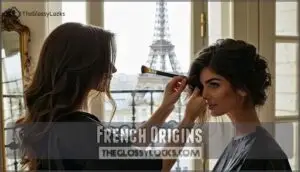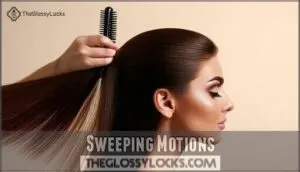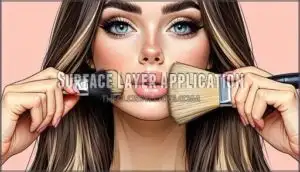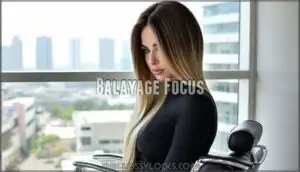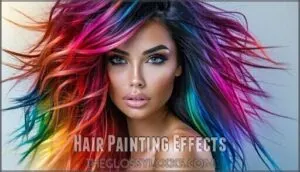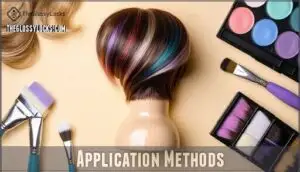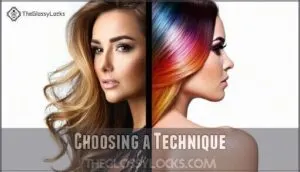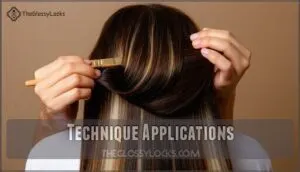This site is supported by our readers. We may earn a commission, at no cost to you, if you purchase through links.

You’ll find that balayage uses specific sweeping motions to mimic natural sun-lightening patterns, while hair painting gives your colorist complete creative freedom to place highlights anywhere they envision.
Think of balayage as following a recipe – it’s got structure and predictable results.
Hair painting? That’s more like freestyle cooking where your stylist can paint color exactly where your hair needs it most.
Both techniques work on surface layers, but hair painting allows for more customized placement and organic-looking results that complement your unique features and lifestyle perfectly.
Table Of Contents
- Key Takeaways
- Hair Painting Basics
- Balayage Technique
- Key Differences
- Maintenance Requirements
- Choosing a Technique
- Technique Applications
- Frequently Asked Questions (FAQs)
- What is the difference between balayage and Pintura highlights?
- What is the downside of balayage?
- What’s the difference between hair painting and highlights?
- How much does balayage cost compared to traditional highlights?
- Can balayage work on dark or damaged hair?
- How long does each technique take in salon?
- What hair lengths work best for each method?
- Do these techniques cause significant hair damage?
- Conclusion
Key Takeaways
- You’ll get predictable, natural-looking results with balayage’s structured sweeping motions, while hair painting offers complete creative freedom for customized color placement anywhere you want it.
- Balayage requires touch-ups every 10-12 weeks and works best on medium to long hair, while hair painting demands more frequent maintenance but adapts to any hair length.
- You’ll pay more for balayage due to its specialized technique and longer appointment times (2-4 hours), compared to hair painting’s 1-3 hour sessions.
- Balayage causes less damage since it’s applied sparingly to surface layers, while hair painting allows for bolder, more dramatic effects but may require deeper saturation.
Hair Painting Basics
Hair painting gives you complete creative control over color placement, letting you customize highlights exactly where you want them using freehand techniques.
Perfect control meets artistic freedom—paint your highlights exactly where you want them.
Unlike traditional foil methods, you’ll apply color directly to hair sections with brushes or hands, creating organic, natural-looking results that mimic how sunlight naturally lightens your hair.
Freehand Color Techniques
Your colorist’s freehand coloring transforms hair into personalized Hair Art through strategic Color Placement.
Unlike traditional foil methods, this balayage technique uses precise Brush Strokes to apply lightener without barriers.
You’ll achieve naturallooking highlights with superior Tonal Balance as your stylist paints color exactly where it’s needed.
These Lightener Tips create dimension through careful hair painting that mimics natural sun-kissed effects.
The process involves understanding hair dye techniques to achieve the desired look.
Organic Visual Application
Hair painting transforms your look through organic visual application that mimics nature’s own highlighting process.
You’ll achieve natural-looking highlights and a sun-kissed effect as colorists use painting tools to create visual effects that complement your hair texture.
This freehand coloring approach differs from traditional balayage technique by emphasizing flowing, artistic movements that follow your hair’s natural patterns for authentic results.
The success of hair painting relies on proper use of hair painting tools to achieve the desired natural-looking highlights and a sun-kissed effect.
Customizing Color Placement
You’ll discover that strategic color placement transforms ordinary hair into stunning hair art.
Strategic color placement elevates your hair from ordinary to extraordinary artistic masterpiece.
Unlike traditional highlighting methods, hair painting lets you create custom highlights that follow your hair’s natural flow and complement your facial features.
Here’s how you customize color placement effectively:
- Face Framing Techniques – Place lighter tones around your hairline to brighten your complexion and create a natural sun-kissed effect
- Dimensional Color Strategies – Layer multiple shades throughout different sections to add depth and movement to your overall look
- Tonal Balance Methods – Distribute warm and cool tones strategically to achieve harmonious, multidimensional results
- Sectioning Patterns – Choose vertical, diagonal, or curved placements based on your hair texture and desired outcome
This customized color approach guarantees your balayage technique creates personalized results that enhance your unique features.
Balayage Technique
Balayage originated in France during the 1970s, where stylists developed this sweeping technique to create natural-looking highlights.
You’ll recognize balayage by its distinctive application method, where colorists use light, sweeping motions to paint lightener onto the surface layers of your hair, utilizing a technique that results in natural-looking effects.
French Origins
Balayage emerged from French salons during the 1970s, revolutionizing hair coloring techniques worldwide.
This European influence transformed hair culture by introducing a more natural approach to highlighting.
French stylists developed balayage as an alternative to traditional foil methods, emphasizing artistic hand-painting over mechanical processes.
The technique’s French history reflects styling evolution toward organic, sun-kissed effects that mimic natural color variations, achieving a more natural approach and sun-kissed effects.
Sweeping Motions
Your brush strokes define the entire balayage look.
Motion control becomes your secret weapon—light, feathery movements create natural-looking highlights that blend seamlessly.
Master these sweeping techniques by practicing consistent hand movement patterns.
Start with gentle pressure and gradually build color placement confidence.
Freehand painting requires steady hands and deliberate brush control for professional results.
Surface Layer Application
With balayage techniques, you’ll focus on surface layer application rather than saturating every strand.
This method creates natural-looking highlights by applying lightener application to the top layers where sunlight naturally hits.
Your colorist uses strategic color placement to enhance your hair’s movement and dimension.
Understanding the hair coloring techniques is essential for achieving the desired look.
Here’s how surface painting works:
- Selective strand targeting – Only exterior sections receive freehand painting treatment
- Graduated intensity – Hair sweeping motions create lighter concentration toward ends
- Natural fall patterns – Layering techniques follow your hair’s natural movement
- Controlled saturation – Surface layer application prevents over-processing interior hair
Key Differences
When you’re choosing between hair painting and balayage, you’re looking at two distinct approaches that create very different results.
Balayage focuses on subtle, natural-looking highlights using light sweeping motions on surface layers, while hair painting allows for bolder, more vibrant effects with strategic color placement throughout your hair.
Balayage Focus
You’ll notice balayage targets specific areas where sunlight naturally hits your hair.
This hair painting vs balayage distinction matters because balayage techniques focus on face-framing sections and surface layers.
Your colorist uses strategic color placement with sweeping techniques, creating lighter ends and darker roots.
This targeted lightener application guarantees natural hair color gradation while simplifying regrowth management compared to other hair painting techniques.
Hair Painting Effects
Hair painting releases your creativity through bold, vibrant effects that transform your entire look.
Unlike subtle highlighting, this technique delivers dramatic dimensional color with striking tonal variety.
You’ll achieve eye-catching lightener effects that create maximum impact through strategic color placement.
The freehand approach adapts beautifully to your unique hair texture, producing stunning contrasts and artistic patterns that make a statement with vibrant effects.
Application Methods
Application methods reveal the core distinction between these hair coloring processes.
You’ll use sweeping motions for balayage technique, painting lightener onto surface layers with paddle brushes.
Hair painting methods allow deeper saturation through varied brush techniques and strategic hair sectioning.
Color placement becomes more precise with balayage’s controlled toning methods, while hair painting offers flexible lightener application for customized effects.
Professional stylists often rely on quality balayage kits to achieve the desired results, utilizing hair painting and controlled toning for optimal outcomes.
Maintenance Requirements
When you’re deciding between hair painting and balayage, understanding maintenance requirements helps you choose the technique that fits your lifestyle.
Your hair’s natural color, the size of sections used, and the specific technique all affect how often you’ll need touch-ups.
Technique Dependence
Your maintenance schedule hinges on which technique you choose.
Balayage typically requires salon visits every three months thanks to its strategic color placement and natural regrowth management, while other hair painting methods may demand more frequent touch-ups depending on lightener choice, section control, and your hair texture’s unique response to processing.
To achieve vibrant results, understanding proper hair color maintenance is essential for extending the life of your highlights.
This will help you manage your hair color effectively, ensuring it looks great and lasts longer, which is crucial for maintaining a natural look.
Natural Hair Color
Your natural hair color plays a starring role in determining how often you’ll need touch-ups with hair painting vs balayage techniques.
Both methods work with your base shade rather than against it, creating natural variation and dimension creation through strategic color enhancement.
When your colorist selects tones that complement your existing hair color saturation and undertones, you’ll enjoy seamless regrowth that blends beautifully as new hair emerges, utilizing seamless regrowth for a natural look.
Section Size Impact
Beyond mere technique, section size determines your commitment level. Larger sections mean fewer touch-ups but less precision in color distribution, while smaller sections offer better saturation but require more frequent maintenance visits.
- Hair length affects regrowth visibility – shorter styles show new growth faster than longer hair
- Section size impacts maintenance costs – smaller sections need more frequent salon visits for blending
- Color distribution varies by technique – hair painting vs balayage creates different regrowth patterns requiring unique upkeep schedules
Choosing a Technique
You’ll need to keep in mind your hair goals and lifestyle when choosing between balayage and hair painting techniques.
Balayage offers subtle, low-maintenance highlights that grow out gracefully, while hair painting allows for bolder, more dramatic color effects that require more frequent touch-ups, which can be considered as dramatic color effects.
Balayage Benefits
Balayage delivers four key advantages when comparing hair painting vs balayage techniques.
You’ll achieve a natural look that mimics sun kissed highlights, requiring low maintenance visits every 10-12 weeks instead of monthly touch-ups.
This gentle hair color technique preserves hair health by avoiding root saturation, while creating stunning color depth that enhances your natural beauty effortlessly.
Hair Painting Advantages
When you’re exploring hair coloring methods beyond traditional highlights, hair painting offers distinct advantages that make it worth considering.
This versatile technique provides:
- Color Versatility: Create bold, vibrant effects or subtle dimension
- Custom Results: Target specific sections for personalized placement
- Hair Health: Gentle application reduces damage compared to foiling
- Cost Effectiveness: Often more affordable than specialized French balayage techniques
Hair painting’s flexibility lets you achieve everything from dramatic transformations to natural-looking enhancements.
Understanding the differences in hair coloring techniques is essential for making an informed decision about your hair.
Client Suitability
Your Hair Type, Skin Tone, Personal Style, Lifestyle Needs, and Face Shape all play vital roles in determining whether hair painting or balayage suits you best.
During your hair color consultation, a skilled colorist will assess these factors to recommend the most flattering hair color techniques.
Client suitability depends on your hair’s condition, maintenance preferences, and desired outcome intensity, which are crucial for a successful balayage application.
Technique Applications
When exploring hair coloring options, you’ll find three popular applications that showcase the versatility of freehand techniques.
Free-hand painting, ombre effects, and Pintura highlighting each offer unique ways to achieve stunning color results that complement your natural hair texture and desired look.
Free-Hand Painting
Creative techniques in freehand painting allow you to place color exactly where you want maximum impact.
This Hand Painting method gives you complete control over Paint Effects and Color Placement.
You’ll use specific Brush Techniques to create stunning Hair Art that’s uniquely yours.
Unlike structured approaches, freehand painting lets your creativity flow naturally across each strand.
Mastering freehand painting requires understanding of proper brush techniques to achieve desired results.
Ombre Effects
Ombre effects create stunning color gradation through strategic hair painting techniques that fade dark roots to lighter ends.
You’ll achieve seamless hair progression by varying shade depth and processing time across sections. This tone blending method produces natural dimension effects without harsh lines.
Unlike traditional highlighting, ombre hair focuses on graduated color placement rather than surface streaking.
Professional stylists customize the sunkissed look through careful hair color blending techniques, utilizing strategic hair painting techniques to achieve the desired effect.
Pintura Highlighting
Pintura Method revolutionizes highlighting techniques by strategically painting curls to enhance natural hair movement.
This DevaCurl-developed approach treats each curl as a canvas for Color Placement, using precise Lightener Tips to follow your hair’s unique contour pattern.
Unlike traditional balayage, pintura creates Hair Contour effects that work with curly textures, placing highlights where they’ll catch light naturally and complement your curl formation.
Frequently Asked Questions (FAQs)
What is the difference between balayage and Pintura highlights?
Balayage uses sweeping motions to paint color onto hair’s surface layers, while Pintura highlights target specific curly hair sections for enhanced curl definition and movement.
What is the downside of balayage?
You’ll face higher costs and longer salon appointments since balayage requires advanced skills and specialized techniques. The process demands more time than traditional highlighting methods, making it expensive.
What’s the difference between hair painting and highlights?
Hair painting gives you creative freedom to place color anywhere on your hair, while traditional highlights use foils for uniform, structured placement throughout specific sections.
How much does balayage cost compared to traditional highlights?
You’ll typically pay more for balayage than traditional highlights since it requires advanced skills and longer appointment times.
Expect balayage to cost substantially more, reflecting the specialized technique and artistry involved.
Can balayage work on dark or damaged hair?
Like a phoenix rising from ashes, damaged hair can embrace balayage’s transformative power.
You’ll need skilled colorists who understand lightening compromised strands carefully, using lower volumes and strategic placement to minimize further damage while creating beautiful dimension.
How long does each technique take in salon?
Balayage appointments typically run 2-4 hours since you’re getting precise, hand-painted highlights. General hair painting techniques usually take 1-3 hours depending on your desired coverage and complexity.
What hair lengths work best for each method?
Length is everything" – you’ll find balayage works beautifully on medium to long hair where sweeping motions create natural gradients.
While general hair painting techniques adapt to any length, including short styles.
Do these techniques cause significant hair damage?
Both techniques can damage your hair since they use bleaching agents to lighten strands.
However, you’ll experience less damage with balayage because it’s applied more sparingly and processes in open air, creating gentler results than traditional foils.
Conclusion
Remarkably, both hair painting vs balayage techniques emerged from colorists seeking more natural-looking highlights, yet they’ve evolved into distinctly different approaches.
Your choice depends on whether you prefer balayage’s predictable, structured results or hair painting’s customized artistry.
Consider your lifestyle, maintenance preferences, and desired look when deciding.
Balayage works well for classic dimensional color, while hair painting excels at creating unique, personalized effects that complement your specific features and hair texture perfectly, achieving a more natural-looking and personalized result.

